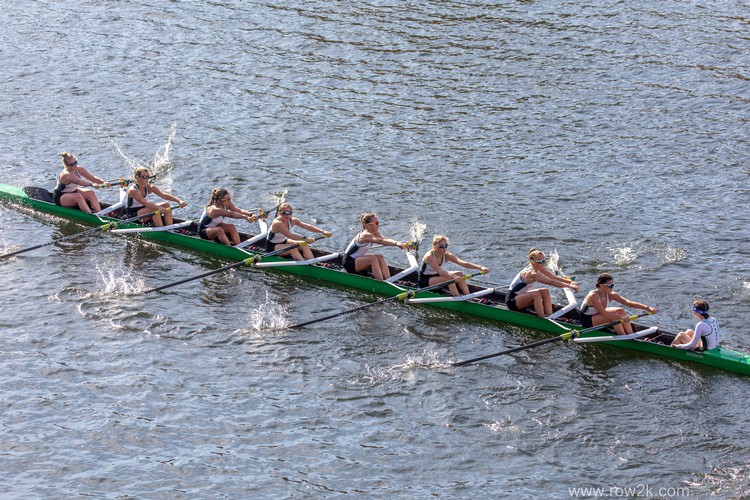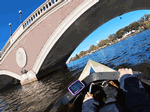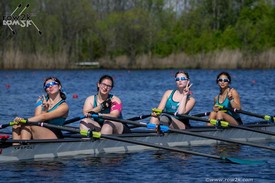In the Driver's Seat, with Anna McCarthy
John FX Flynn

Next up In The Driver's Seat—-where we hear from the folks who add that extra something to the teamwork of a crew—-is Anna McCarthy.
Anna, a high school junior, calls herself "an avid reader" of this series:
"Reading these articles immensely improves my coxswain skill set every week," she says, and we are excited that she was willing to return the favor by sharing her own experiences.
She coxes at Nardin Academy in Buffalo and West Side Rowing Club, where she raced to Canadian Henley gold last summer with her teammates in West Side's U17 Women's Eight .
Let's hop In The Driver's Seat with Anna:
row2k - What do you see as the three most important things for being a successful coxswain?
Anna McCarthy -My top three essentials for being a successful coxswain are safety, effectiveness, and communication.
Safety - My number one priority at practice and on race day is safety. Checking over my hull and communicating any concerns to my coaches before and after practice or a race is essential to creating trust with my coach and rowers, as well as preventing any mishaps. Additionally, while coming down the course I must be hyper aware of my surroundings and watch out for wind, turns, other crews and anything else that may affect me or my crew.
For example, in case of a strong wind it is necessary to point into the wind and overshoot while docking. Being prepared for this before facing the situation maintains a smooth, calm and efficient outcome. When it comes to steering around a turn or other crews, it is effective to be deliberate in using my port and starboard sides. Being aware of these obstacles before leaving the dock is essential, but they can come up suddenly, too; in that case, I think strategically and quickly in order to run a smooth race or practice. If the obstacle seems to be unavoidable, I evaluate what the safest and most efficient and necessary option is and follow that. My reaction in a piece, a race, or a seat race must take into account my line; in contrast, while doing drills I may be able to let it run, drop a pair, or move over however much it is necessary to avoid the obstacle all together.
Effectiveness - With commands, things like speed of delivery and intensity are important in being effective. A coxswain's speed of delivery should coincide with the speed of the piece: I mimic what I want. While doing steady state, paddling off, or executing drills it is helpful to be rhythmic and match my tone of voice with each part of the drill and or the rate. The intensity can be more conversational but still clear, with room to focus on what I am saying and how I am saying it.
Everything a coxswain says in any circumstance should mean something and have no room for confusion: the fewer words, the better. While doing a high intensity piece, I am aggressive and have a harsh tone. There is no time for hesitation, so speaking to rowers individually and asking them for what I want from them is important. I talk about what the coaches are focusing on, and say it how I would want to hear it, for maximum grit.
Part of effectiveness is adaptability. Being situationally aware and prepared to adapt for the most efficient result when racing is crucial. It is okay to adjust the race plan if it is necessary to benefit productivity: if we are getting walked on at 800m, I will call our “middle move” then instead of at the 1000m mark.
Communication - When it comes to talking to coaches and other coxswains, a coxswain should be clear and organized. Talking to my fellow coxswains helps keep the boats together while doing drills and making sure everyone is on the same page can help run practice efficiently, and waste as little time as possible.
If a rower asks me to communicate something to a coach, it is important for me to do so because the rowers play the most vital role in a fast boat. If a rower tells me that they like a specific call or want me to repeat something to another teammate, it is important to evaluate that. Talking to my rowers calmly and listening for peer evaluation is vital to molding the coxing style necessary to assist my crew in going fast.
In addition, using information as motivation is imperative. I make split, rate, time, distance, and where we are on the course versus other crews my top priority in race calls. I have been told over the years that numbers can motivate a crew more than many other 'motivational' calls because it is clear to them what they need to do and for how long. Rowers are thinking 'when is this over?' and 'are we winning?' I keep my crew informed, and make sure not to leave anything to imagination.
row2k - What is your favorite drill to run with your crews? Any tips on how to the drill well, for maximum effectiveness?
Anna McCarthy - My favorite drill to run at practice is a Nardin special called 'Sara Gaughan'--this drill sometimes takes our team all practice to master because it is so time consuming and specific.
It consists of a progression: pick, swing, quarter slide, half slide, and then full slide. The crew, starting with picking (arms only), rows continuously for ten strokes and then pausing for ten at the finish, and we repeat those steps while progressing through the stroke every set of twenty. This drill takes time and it takes practice to be able to call it correctly and with fluidity. When performed correctly, 'Sara Gaughan' can drastically improve how my crew rows together and picks apart the stroke for effective critiquing.

To do any drill well, it is important that the rowers understand why they are doing the drill beforehand, and that the purpose is repeated throughout the execution. In order for maximum effectiveness, the rowers must know exactly what they are doing, for how long, and why. Calling transitions and each part with precision and the least words possible can prevent confusion and keep the rowers engaged.
row2k - What's some of the best coaching advice you've received about your coxing?
Anna McCarthy - This past summer my coach and I went over one of my coxswain recordings. She told me that she was impressed by what I was saying, but not by how I was saying it.
She told me that tone of voice and the speed of talking are large factors in setting the tone for a piece. Speaking to match each part of the stroke--like a breathy recovery and deep drive--can bring together the timing and rhythm as well as add or decrease pressure. This piece of advice sticks with me every time I cox and has transformed the reaction of my rowers by giving them what they need to stay interested and move as a unit through the pain.
I often return to this same coach for advice when I feel stuck or unmotivated. She is a former college coxswain so I know I can always count on her to understand my perspective and give me advantageous critiques.
row2k - What is a mid-race call or move that you've made that you'll remember for the rest of your life? If so, what did it involve and how did you call it?
Anna McCarthy - A mid race call that sticks with me is from this past summer at Canadian Henley.
My coach and her father were our biggest supporters on the path to Henley this summer. My coach was honest and distinct in her critiques, and worked on perfecting the technical aspects as well as specific calls. Every day after practice, her father would tell us how proud he was of us for putting everything out on the table and he quickly became one of our biggest motivations when racing.
While it was not in the very strategic and specific race plan, I decided to take a power ten for him when we pulled even with our biggest competitor. Honoring this coach got my crew emotional and reminded them that they needed to pull harder for someone other than themselves or the boat. Without his drive and encouragement, we would have never been in the position to win at Canadian Henley. The call was: “In two, we press legs for ten to push ahead for Kenny!” That ten instantly had all eight pulling harder and made my calls more passionate. We pulled ahead into first place and held power through the finish line.

row2k - Can you tell us anything about how you learned to steer straight?
Anna McCarthy - As a new coxswain, it is okay to use the rudder as much as needed. Over time I have learned to use it sparingly, because it upsets the boat's balance. I like to have two hands on the rudder, which is a personal preference, but it is necessary to at least have both hands on the shell to maintain a center of gravity and maintain the set.
Once the physical aspect is addressed, the rest depends on what course I am steering. My high school coach is very specific when it comes to steering. She first focused on our home course and perfecting my line there. I did this by looking at the course from the launch, as she specified what I should be looking at and why those points made the most sense. Once we began racing, she was able to relate each turn and bridge to something I had perfected back on our home course. Studying the maps and landmarks as well as knowing what lane I am in during sprint races is necessary to plan ahead for steering the most efficient course. Having a direct point from the very beginning to the very end of the course, whether it is practice or a race, is key to having the fastest line. If there are turns present in the course, being aware of them and planning how to call the most efficient turn beforehand is useful. If there is another crew ahead of me, I can evaluate whether it is quicker and or necessary to tell them to move, or if it is better to move around them. In a piece, a race, or a seat race, a coxswain’s line is precious. It is vital to hold that line in order to row the shortest possible course and get the most accurate results.
A consistently good course builds trust with my rowers as well as my coaches. They know I am paying attention to precision and doing what is best for us as a crew and a team.
row2k - Tell us about the best race/practice you've ever had?
Anna McCarthy - The race that takes the cake for me is last summer's Canadian Henley final.
From the first day of practice it was our goal as a team to put up a good fight at Henley. Every run, erg workout, water practice, and race were all building up to it. After seat racing and swapping to find the perfect set of nine, we focused on getting faster and more skillful as a unit. We were able to look at times and placements from past years, but were still going in blind due to it being the first time at Henley for all nine of us, and our coaches first time back since before Covid-19.
Arriving on race day, anxiety was high and a rock solid plan was set. There was nothing we could do but trust ourselves. I had my lane number, competitors, bow number, event number, the events before and after us, and every buoy memorized. All of these things are extremely important to know in building trust with your crew and being calm for the race.
Once we achieved first in our heat and second overall by two seconds, our dream was at our fingertips. We set off for the final and came to the agreement that there was absolutely nothing stopping us from taking home the gold. After a difficult time setting up in the stakeboat, I said "Take a deep breath. Chests up. This is the good part." Starting off back in third place, we were able to work through the hulls in front of us one at a time, with uniformity. After pulling ahead at around 600m, all nine stayed clean and controlled as each rower pushed off the footboards. The last stroke through the finish line felt surreal, and I am so grateful to have ended off the season with a bang. As a well practiced and determined boat, we felt that all of our work not only from that summer but previous seasons had paid off.
As proud as I am that I had the opportunity to cox that U17 Women's 8+ to victory, all credit goes to the work all eight of those rowers put in to become the fastest, most technically solid versions of themselves for the race.
Thanks for riding along with Anna -- and, remember, this column is open to all "drivers" out there, so if you are an experienced coxswain at any level--from juniors to masters--and would be willing to invite row2k to join you in your ride, just contact us here. We’d love to hear from you about what you see from the Driver's Seat.

If you enjoy and rely on row2k, we need your help to be able to keep doing all this. Though row2k sometimes looks like a big, outside-funded operation, it mainly runs on enthusiasm and grit. Help us keep it coming, thank you! Learn more.
Comments | Log in to comment |
- Bont Rowing
- Calm Waters Rowing
- Concept 2
- Craftsbury Sculling
- The Crew Classic
- CrewLAB
- Croker
- Dad Vail Regatta
- Durham Boat Co.
- Empacher
- Faster Masters
- Filippi
- Fluidesign
- h2row.net
- HUDSON
- Live2Row Studios
- Nielsen-Kellerman
- Oak Ridge RA
- Peinert Boat Works
- Pocock Racing Shells
- Race1 USA
- Rockland Rowing Masters Regatta
- RowKraft
- Rubini Jewelers
- Vespoli USA
- WinTech Racing
- Bont Rowing
- Calm Waters Rowing
- Concept 2
- Craftsbury Sculling
- The Crew Classic
- CrewLAB
- Croker
- Dad Vail Regatta
- Durham Boat Co.
- Empacher
- Faster Masters
- Filippi
- Fluidesign
- h2row.net
- HUDSON
- Live2Row Studios
- Nielsen-Kellerman
- Oak Ridge RA
- Peinert Boat Works
- Pocock Racing Shells
- Race1 USA
- Rockland Rowing Masters Regatta
- RowKraft
- Rubini Jewelers
- Vespoli USA
- WinTech Racing


















02/10/2023 4:22:38 PM